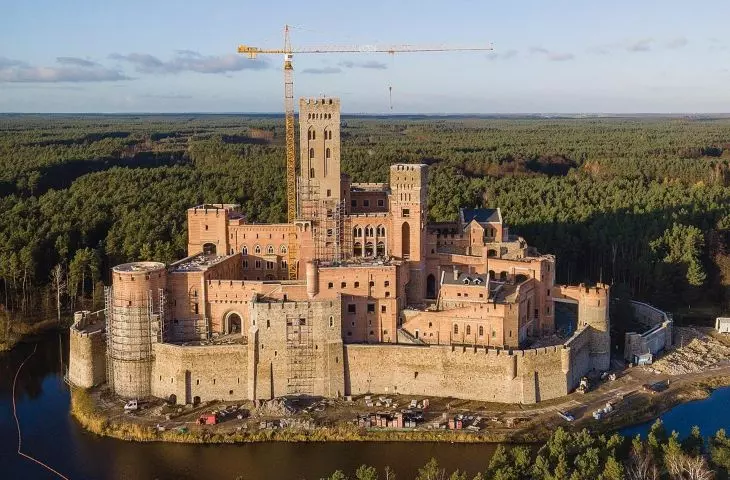Another episode of the series starring the so-called castle is behind us. The realization of the gigantic and highly controversial building in Stobnica can continue. This is what the Provincial Administrative Court in Warsaw decided, overturning the decision of the General Inspector of Building Supervision last summer. At the time, the GINB invalidated the construction permit for the castle-like moloch. "It remains for us to minimize the negative effects of this investment," - concludes the chairman of the Poznan SARP.
The decision of the capital's WSA is another setback to the construction of the now-famous "castle" in the Wielkopolska town of Stobnica (oborniki district). In August last year, the Chief Inspector of Building Supervision annulled the building permit for the objectionable structure, issued in 2015, and the decision of the Wielkopolska voivode upholding it (more: here). The investor, the company D.J.T., however, appealed the GINB's decision to the Regional Administrative Court in Warsaw. As PAP reported yesterday, almost a month ago, in a closed session, the WSA decided to annul the chief inspector's decision. Construction will therefore continue. According to GINB spokeswoman Joanna Niedźwiecka, quoted by the media, the investment can continue until the final judgment in its case.
This is not the first twist in this unusual story. Let's recall the main facts: the realization of a giant building in the form of a castle has been underway in Stobnica since 2015. The main designer is Waldemar Szeszuła, a Poznan architect, urban planner and lecturer at the Poznan University of Technology. The building, which is nearing completion, is being built on an artificial island in the middle of a pond on the Kończak Canal on the southern edge of the Notecka Forest. Ultimately, it is to have about 14 floors, with a tower towering over the whole, which, according to various arrangements, is to be 60 to 70 meters high.
highland on lowland
The building, although erected on flat terrain, pretends to be an upland castle, whose irregular forms were subordinated by the architect to a fictional history of development: from the medieval fortress at the "summit," through subsequent additions and extensions, up to the 19th century. The historicizing building is therefore not stylistically homogeneous, it is also a kind of urban composition: with squares, courtyards and tracts.
The investment only became notorious in 2018, when the building, previously hidden from outsiders, reached sizable proportions. Published on the Internet, the media became interested in the case, determined who the investor was, and reported that the "castle" stands in a Natura 2000 area in the current of a canal owned by the State Treasury. The form was controversial, while the scale and location received almost universal criticism.
The case was taken up by the CBA, which investigated the legality of the decisions and permits issued. The General Director of Environmental Protection was obliged to inspect, and the case also went to the prosecutor's office. In 2019, the Regional Directorate for Environmental Protection in Poznan revoked its own decision from 2015, which stated that the investment had no negative impact on the environment. The change came when it turned out that the construction site was more extensive than the documents stated (the WSA in Warsaw, however, overturned this later GDOŚ decision in March 2021).
legal rollercoaster
Events picked up speed in 2020. In July, the prosecutor's office charged seven people: officials, representatives of the investor and the chief designer. Six months later, the indictment included six people (details of the indictment: here). The defendants pleaded not guilty, and the trial has not begun to this day, because the Oborniki District Court decided that it did not have jurisdiction and requested that the case be transferred to another equivalent court. On the other hand, in November 2020, the then Greater Poland Voivode, Lukasz Mikolajczyk, recognized the validity of the construction permit issued in 2015 by the Oborniki district governor. This decision was paid for by the governor after a few days in office. It was it that the GINB annulled last year.
How does a representative of the community of Wielkopolska architects look at this case? Wojciech Krawczuk, president of the Poznan branch of the Association of Polish Architects, comments:
Regardless of my opinion on the "castle," judging by the history of this astonishing case, I suppose that ultimately the demolition will not take place. If only because of the huge amount of money placed in this investment. The saddest thing is that so many representatives of local authorities were involved in making this project possible, which proves how weak the sensitivity regarding the development of this space is.
collective refusal
Krawchuk adds that the most important thing now is to minimize the harmful impact of the structure on the natural surroundings, including by preventing the owner from using the building for any other purpose (such as a hotel) than the originally declared residential functions. What about the responsibility of the chief designer?
I tried to contact him, he is a member of our association. Unfortunately, we have not heard back from him. An architect has the right to design a building with an unusual form if he does not break the regulations, which I am not in a position to judge here. However, I believe that he should have evaluated more carefully how much this investment could harm the environment, nature and general respect for spatial order. After all, the protected landscape is the property of the whole society. Who knows, maybe if he had said no, and subsequent planners had done the same, the developer would have reflexed and changed his intentions, Krawchuk comments.
He adds that there are many historic palaces and castles scattered around Poland waiting to be renovated or saved from destruction. And it is these that the investor could take care of, while gaining public respect.

















